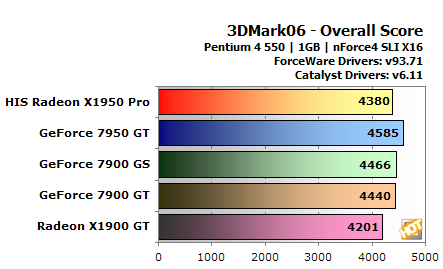HIS Radeon X1950 Pro IceQ3 Turbo
Testing System & 3DMark06

HOW WE CONFIGURED THE TEST SYSTEM: We tested the HIS Radeon X1950 Pro IceQ3 Turbo on the Gigabyte GA-8N-SLI - an nForce 4 Intel Edition SLI X16 chipset-based motherboard - powered by an Intel Pentium 4 550 processor and 1GB of Corsair XMS2 DDR2 memory. The first thing we did when configuring this test system was enter the BIOS and loaded the "High Performance Defaults." The hard drive was then formatted and Windows XP Professional with SP2 was installed. When the installation was complete, we installed the latest nForce 4 chipset drivers, installed all of the other necessary drivers for the rest of our components, and removed Windows Messenger from the system. Auto-Updating and System Restore were then disabled, the hard drive was defragmented, and a 1536 MB permanent page file was created on the same partition as the Windows installation. Lastly, we set Windows' Visual Effects to "best performance," installed all of the benchmarking software, and ran the tests.
|
|
|
|
Motherboard - Video Cards - Memory - Audio - Hard Drive -
|
Hardware Used: Intel Pentium 4 550 (3.4GHz) Gigabyte GA-8N-SLI Quad Royal nForce4 SLI X16 chipset Asus EN7950GT Asus EN7900GS TOP Asus EN7900GT TOP HIS Radeon X1950 Pro Sapphire X1900 GT 1GB Corsair XMS2 DDR2 Integrated 2x Western Digital SE16 (RAID 0) 7,200RPM - SATA II - 250GB |
OS - Chipset Drivers - DirectX - Video Drivers - Synthetic (DX) - DirectX - DirectX - DirectX - DirectX - OpenGL - OpenGL - |
Relevant Software: Windows XP Professional SP2 nForce Drivers v6.86 DirectX 9.0c NVIDIA Forceware v93.71 ATI Catalyst 6.11 Benchmarks Used: 3DMark06 v1.0.2 Splinter Cell: Chaos Theory v1.05 F.E.A.R. v1.0.7 Half Life 2 - Lost Coast Need for Speed:Carbon Quake4 v1.2 Prey |
|
|
|
| Futuremark recently updated their suite of benchmarks, including 3DMark06. The latest version of the benchmark was updated in a number of ways and now includes not only Shader Model 2.0 tests, but also Shader Model 3.0 and HDR tests as well. Some of the assets from 3DMark05 have been re-used, but the scenes are now rendered with much more geometric detail, and the shader complexity is vastly increased as well. Max shader length in 3DMark05 was 96 instructions, while 3DMark06 ups the number of instructions to 512. 3DMark06 also employs much more lighting, and there is extensive use of soft shadows. With 3DMark06, Futuremark has also updated how the final score is tabulated. In this latest version of the benchmark, SM 2.0 and HDR / SM3.0 tests are weighted, and the CPU score is factored into the final tally as well. |



Although there is marked improvement from the X1900 GT to the HIS X1950 Pro - typically in the range of 3-5% - the end result is that the X1950 Pro remains behind a triple helping of GeForce cards, although to be fair, the 7900 GT and GS cards that were used also came with some higher speeds than the standard variety. The HIS card did stand out in the HDR/Shader Model 3.0 testing, however, where it placed a close second to the lead card, the GeForce 7950 GT.







